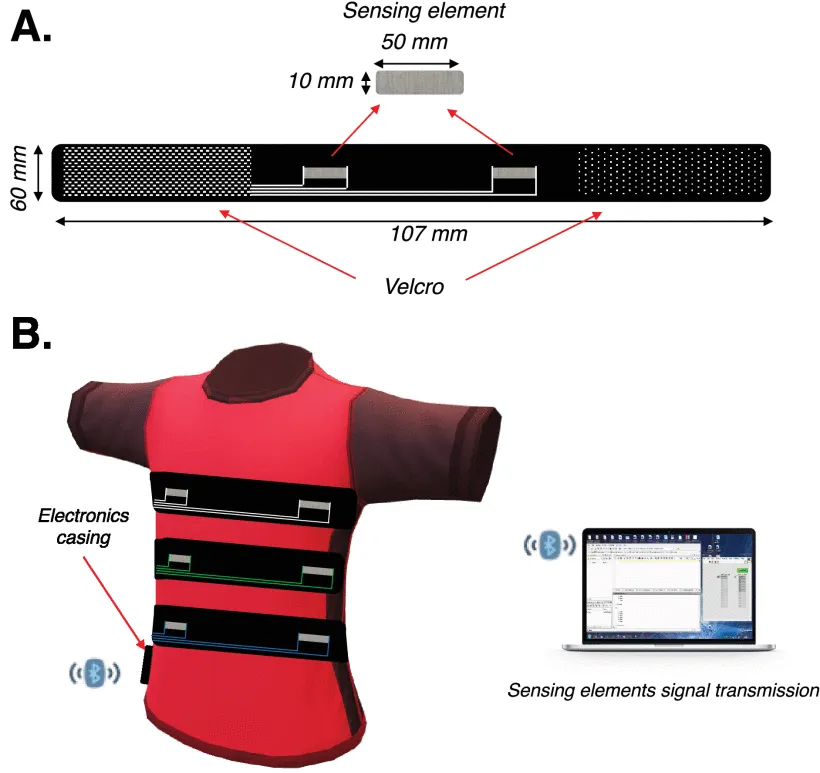Respiratory Monitoring During Physical Activities with a Multi-Sensor Smart Garment and Related Algorithms
Respiration rate is a vital parameter due to its sensitivity to physical, mental, or environmental stress. It plays a crucial role in the early diagnosis of the health status of patients by detecting abnormalities in breathing patterns. At present, electrocardiography (ECG) and photoplethysmography (PPG) are the most used techniques for respiration measurement. Other methods are classified as contactless and contact-based methods. However, accuracy of many of these methods is highly sensitive to breathing-unrelated body movements.
Smart wearable devices have opened up new research opportunities in real-time health monitoring in various fields, such as healthcare, sports, industry, and armed forces. Recent developments in material processing have made it possible to weave smart textiles using conductive yarns. They provide real-time continuous monitoring in unstructured conditions.
One of such wearables uses piezoresistive sensing element. The resistance of a piezoresistive element changes with strain variation applied to it. A wearable piezoresistive sensor can transduce the rhythmic expansion and contraction of the chest wall into a signal. These sensors can be produced as conductive yarn and are then embedded into the fabric. A smart vest was manufactured by stitching three elastic bands consisting of two piezoresistive sensors of 50x10 mm2 each into the vest. The bands are positioned to cover the upper thorax, lower thorax, and abdomen area. The data of change in resistance is fed into a customized Data acquisition board (DAQ).
The proposed multi-sensor smart garment was evaluated in an experimental setup. The volunteers had to walk or jog at different constant speeds on a treadmill while wearing the vest. Good body adherence was ensured by adjusting each volunteer's sensor bands. This would help reduce the interference from movements other than breathing on output. During data processing, customized algorithms like Bespoke algorithms can further lessen the impact of motion artefacts.
A flowmeter placed on the treadmill at mouth level records the reference pattern of inhalation and exhalation. To isolate respiration-unrelated movement data, only data of frequency range 0.05 – 2 Hz was filtered for analysis. Data from the flowmeter and DAQ were sent to a computer for further processing.
The readings were taken for activities like rest and walking on a treadmill at different speeds. In the rest position, a breathing pattern, 60 secs of self-paced breathing followed by 10-20 secs of apnea, was tried to help synchronize the smart garment signals with flowmeter signals. For walking/jogging, readings were taken for 60 seconds at five different speeds and recorded for data.
The power spectral density (PSD) for each signal was computed using Welch's overlapped segment averaging estimator. The PSD spectra are further normalized to reduce the error due to environmental interference. The results were plotted both in frequency as well as time domain.
Bland-Altman analysis indicated that the respiratory rate values obtained from the smart garment are close to the corresponding reference values obtained from the flowmeter.
Though conducted in a controlled environment on a healthy group of male volunteers only, the experiments tried to replicate typical sports activities in daily life like walking and running. However, it is recommended to conduct more studies involving various anthropometrics volunteers in more realistic daily life activities simulations. Multi-sensor smart garments significantly improved the respiratory monitor's performance. It showed great potential in developing efficient, noninvasive, and unobtrusive respiration rate monitors.




